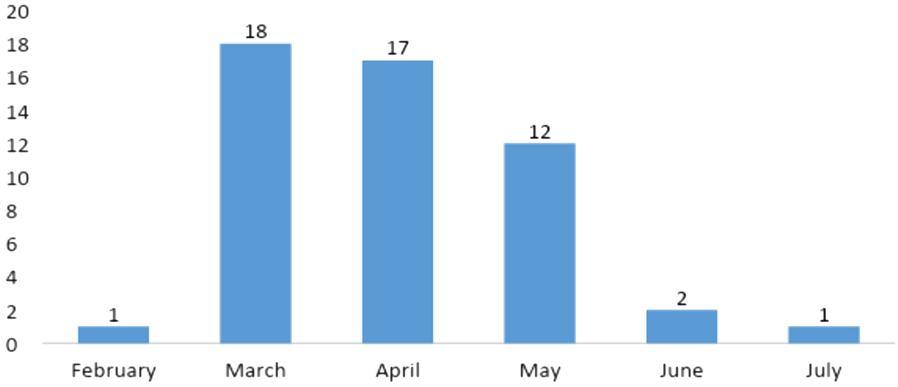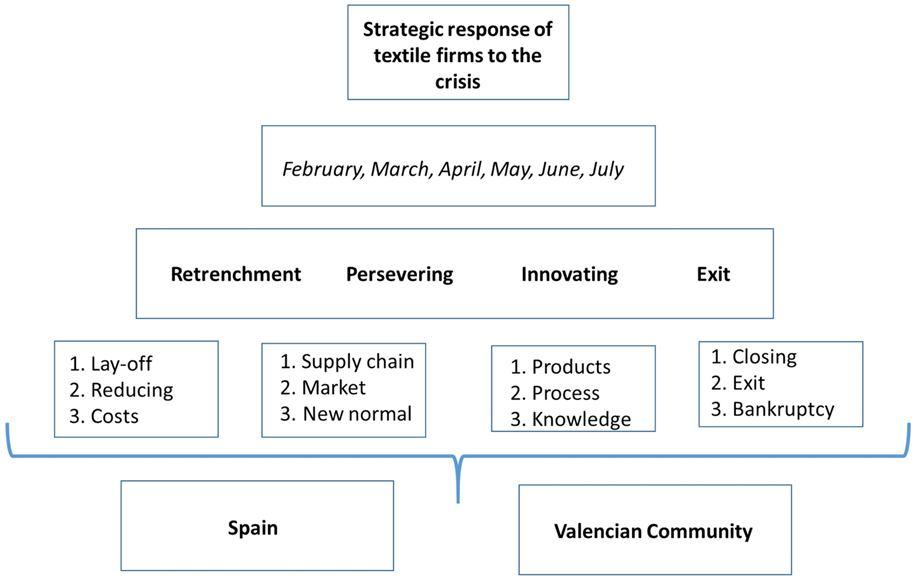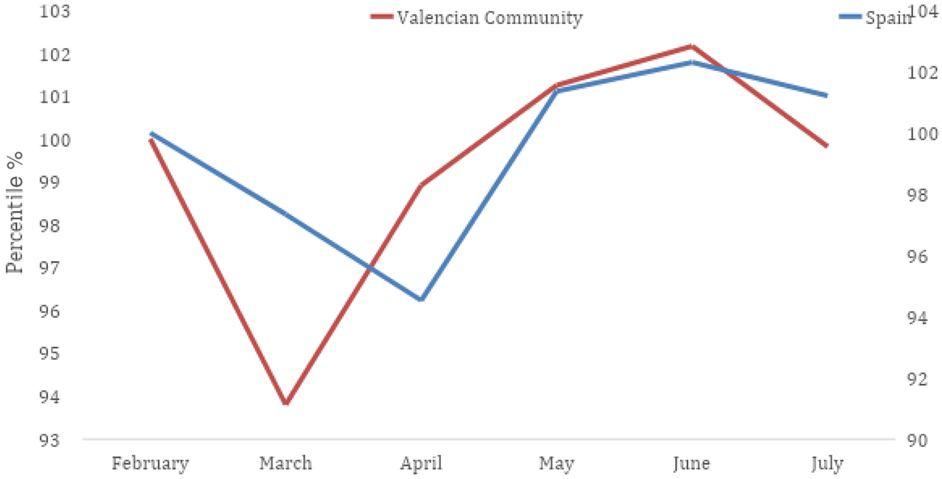

Effect of COVID-19 on Textile Industry
Satyashree Pattanaik1, Sumit Kumar Das2

1Odisha University of Technology and Research, Bhubaneswar

2KIIT University, Bhubaneswar
Abstract: Since the pandemic situation was officially declared, part of society was immersed in searching desperately for solutions to combat it. Textile firms addressed with uneven effectiveness the challenge of creating products that helped medical and civil professionals (e.g., personal protection equipment, masks, sanitary material, etc.). To do this, they had to face supply problems, lockdown, and had to make a significant innovative effort. This work aims to analyze the strategic response of the companies belonging to the Valencian Textile Cluster (VTC) to the coronavirus crisis and the territorial factors that influenced it. We carried out a report analysis of the news during February July (2020). Our analysis revealed that, on average, VTC firms responded to the challenge more quickly and effectively than other textile firms. The most influential location specific factors were the clustering developed, institutional support, and a deep rooted tradition in producing technical home textiles, although we also detected that social media collaborated in the process of transferring value information. The influence of all these factors was more intense in the epicenter of the cluster. Consequently, our results highlight the cluster effect and offer lessons that can help manage unexpected future events more effectively.
Keywords: TEXTILE INDUSTRY, COVID-19, INNOVATION, VTC
I. INTRODUCTION
When the pandemic coronavirus was announced in early 2020 and, among other things, production at textile companies was halted, global supply chains were starved for textile materials and essential products (yarns, fabrics, and other goods). In a few weeks, the risks of globalization and external dependence for manufacturing textile products became evident. For example, the fashion giant Inditex was almost paralyzed due to its suppliers' shortage of raw materials and supply problems. The supply chain disruption also affected other textile firms thathad to buythe materials from different suppliers located more closely. The alarm was raised regarding the limited capacity to respond and produce products that would help to combat the pandemic (e.g., personal protection equipment, masks, sanitary material, etc.). Expressly, when on March 11, 2020, the World Health Organization (WHO) officially declared the spread of the COVID 19 pandemic, society immediately found itself in a race against time to fight the virus more effectively. we witnessed homemade inventions, socialinitiatives, andan exemplaryrapidandinnovative response from thetextile industry. It strived to meet this challenge of protecting the population. Moreover, when the lockdown was declared, some textile areas, far from closing the factories and ceasing production, began to carry out intense and innovative activities, working together in solidarity to respond to the needs of doctors and nurses who needed essential supplies. Therefore, the objective of this work is to analyze the response of the VTC's firms to the coronavirus crisis and the territorial factors that influenced it. For this, we carried out a report analysis of the news that appeared during February July (2020). According to report, our work concludes that in the VTC, the strategic response can be labelled as mainly innovative.
II. LITERATURE REVIEW
The textile clothing industryis one of the main economic sectors, and it is regarded as one of the traditionalmanufacturing industries. The European Commission (2020) defined the textile industry as belonging to a set of diverse and heterogenic industries that produce a wide variety of products, from synthetic yarn derived from high technology to woollen fabrics, cotton bed linen, industrial filters, nappies, and haute couture. This final product diversification is correlated with a copious number of industrial processes, companies, and market structures.
Engineering Technology (IJRASET)

ISSN: 2321 9653; IC Value: 45.98; SJ Impact Factor: 7.538 Volume 10 Issue IX Sep 2022 Available at www.ijraset.com
The 2019 novel coronavirus pandemic (COVID 19) has determined the value of products and their functions; the security of employees in the healthcare system, people in general, and those who depend on the industry. Without anydoubt, the importance of it and it’s influence on the economic sphere has increased significantly. According to the Eurostat Report (2020), it is impossible to construct cars, planes, buildings, agricultural equipment, and military machines for defence and security without textile materials.
III. METHODOLOGY
Thisresearch aims to analyze theresponse of the VTC's firms tothe coronavirus crisis and the territorial factors thatinfluenced it. The research questions, objectives, and the studied context, we carried out a content analysis of the news that appeared during February July(2020). Thismethodologyhas been used byJoshi andSwarnakar (2021)and Shin etal. (2021)tostudythe socialreaction offirms to the COVID 19 crisis. In our research, the content analysis has been carried out in several sectors of textile industry, including in the FACTIVA database, during the period from March to June 2020, coinciding with the period of total confinement due to COVID 19. For our purposes, the content analysis has the advantage of allowing the identification and classification of the news that appeared in the written press during the lockdown as a proxy of strategic responses.
Figure 1. Umbrella research design

IV. RESULTS AND ANALYSIS
The study's finalperformance indicateshowmuchreportshasbeen published consideringthe month ofpublication, the firm's strategic response, and where it has been produced, thus allowing the starting point for the following discussion. The evolution by month for each analyzed report is showed in Fig. 2.
Figure 2. Evolution of the analyzed report between February and July (2020)

After this analysis, we obtain two important conclusions. First, according to the evolution of the reports, the textile industry was on social media, especially during the three first months (March, April, and May) in which its firms were more involved in the challenge of creating products that could help medical and civil professionals, and under a situation characterized as highly complex (supply problems, homebound workers, and lacking technology). Second, we observed that 70% of the content referred to responses that can be classified as innovating (63), while the remaining 27 (30%) can be categorized out of this group. Specifically, 3 of them were exit, 6 persevering, and 18 retrenchment 20%.

ISSN: 2321 9653; IC Value: 45.98; SJ Impact Factor: 7.538 Volume 10 Issue IX Sep 2022 Available at www.ijraset.com
As aresult ofthe analysis, we can conclude thatexistedan uneven performance inthe strategicresponse ofthe textile firms. According to the reports, firms belonging to the VTC battled against the coronavirus crisis, mainly implementing an innovator response.
Fig 3. Evolution of the affiliation of workers in textile clothing industry.
V. CONCLUSIONS

The main objective of this work was to analyze the strategic response of the VTC's firms to the coronavirus crisis and the territorial factors that influenced it. This analysis revealed that, as happened in the fashion industry, the textile industry responded heterogeneously. At thenationallevel, most firms implemented retrenchment strategies. While at theregionallevel, organizations that formed part of the so called VTC developed innovative strategies, which helped combat the pandemic. The factors and capabilities that influenced this response were structural and circumstantial Given the complexityof the current international competitive scenario and the risk of unexpected future events, three essential lessons can be drawn: (1) At a strategic level about having little control over the supply and value chain (2) Regarding the location specific and competitive advantages that proximity and clustering can provide to businesses (information, knowledge, trust, flexibility). (3) For politicians and on the strategic value of the textile clothing sector, particularly for society and the economy.

VI. ACKNOWLEDGMENTS
We would like to extend our heartfelt gratitude to several individuals for supporting and guiding us throughout this project. First, we would like to thank our HOD, Dr. Bibhu Prasad Dash, for giving us this opportunity to widen the horizons of us knowledge through this significant and promising project. Our sincere thanks to Mrs. Swagatika Giri ma’am for her enthusiasm, patience, insightful advice, and necessary critiques that have helped us tremendously in completing the report successfully. Her profound knowledge and expertise in “TEXTILE” enabled us toprepare thereport in the best possible way. We are deeplyindebted to my group member for their useful contributions, constructive criticisms, and unwavering support throughout the project. All their efforts are worth appreciation. Wereallyhada great time working with each other. We are extremelygrateful toour families and peers for constantly providing us with all the necessities and moral support so that our work may go on smoothly. Thanks to everyone who helped us directly or indirectly in completing this report on time.

REFERENCES
[1] Ambrosini, V., & Bowman, C. (2009). What are dynamic capabilities and are they a useful construct in strategic management? International Journal of Management Reviews, 11(1), 29 49.
[2] Barker, V. L., & Barr, P. L. (2002). Linking top manager attributions to strategic reorientation in declining firms attempting turnarounds. Journal of Business Research, 55(12), 963 979.
[3] Belso Martínez, J. A., Mas Tur,A., & Sánchez, M. (2020). The COVID 19 response systemand collective social service provision. Strategic network dimensions and proximity considerations. Service Business, 40(14), 387 411.
[4] Barker, V. L., & Duhaime, I. (1997). Strategic Change in the turnaround process: Theory and empirical evidence. Strategic Management Journal, 1(18), 13 38.
[5] Capó Vicedo, J., Expósito Langa, M., & Masiá Buades, E. (2007). La importancia de los clústeres para la competitividad de las PYME en una economía global. EURE (santiago), 33(98), 119 133.

